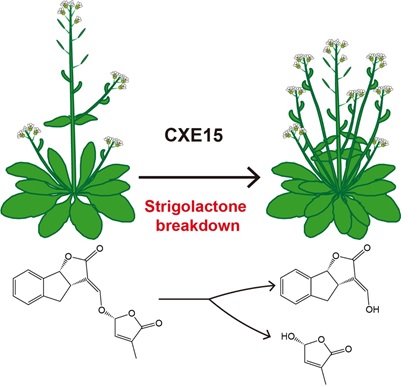Researchers led by Prof. HU Yuxin from the Institute of Botany of the Chinese Academy of Sciences recently reported that the Arabidopsis carboxylesterase 15 (AtCXE15) and its orthologues in seed plants function as efficient hydrolases of plant hormone strigolactones (SLs). This discovery reveals the catalytic mechanism underlying homeostatic regulation of SLs in plants.
Relevant results were published online in Nature Plants.
SLs are a class of carotenoid-derived plant hormone that plays critical roles in regulation of plant shoot branching, plant-fungi symbiosis, and germination of parasitic weeds. Recent studies have outlined biosynthetic and signaling pathways of SLs, however, the catabolism or deactivation of endogenous SLs in planta has remained largely unclear.
In this study, the researchers showed that overexpression of AtCXE15 in Arabidopsis promotes shoot branching by dampening SL-inhibited axillary bud outgrowth. Meanwhile, they demonstrated that AtCXE15 could bind and efficiently hydrolyze diverse SLs both in vitro and in planta.
Furthermore, they also demonstrated that the putative AtCXE15 orthologues from a few species of dicots, monocots, and Gymnosperms, but not from bryophytes, could efficiently degrade SL analogues, indicating that such CXE15-dependent catabolism of SLs is evolutionarily conserved in seed plants.
Interestingly, the researchers found that AtCXE15 is highly responsive to SLs and diverse environmental stimuli. This implies that CXE15-mediated SL catabolism might be a regulatory mechanism of SL gradients and thus shape plant architecture under ever-changing environments.
“Since endogenous SL gradients in plants are crucial for determining the axillary bud outgrowth and shoot branches, the manipulation of endogenous SLs and signaling would be an approach to improve crop productivity and resilience,” said Prof. HU, corresponding author of the study.
This study also provides a rational approach to spatial-temporally manipulating endogenous SLs and the architecture of crops and ornamental plants.

CXE15 hydrolyzes SLs to promote shoot branching
Contact:
HU Yuxin, Institute of Botany, CAS
Email: huyuxin@ibcas.ac.cn
Researchers led by Prof. HU Yuxin from the Institute of Botany of the Chinese Academy of Sciences recently reported that the Arabidopsis carboxylesterase 15 (AtCXE15) and its orthologues in seed plants function as efficient hydrolases of plant hormone strigolactones (SLs). This discovery reveals the catalytic mechanism underlying homeostatic regulation of SLs in plants.
Relevant results were published online in Nature Plants.
SLs are a class of carotenoid-derived plant hormone that plays critical roles in regulation of plant shoot branching, plant-fungi symbiosis, and germination of parasitic weeds. Recent studies have outlined biosynthetic and signaling pathways of SLs, however, the catabolism or deactivation of endogenous SLs in planta has remained largely unclear.
In this study, the researchers showed that overexpression of AtCXE15 in Arabidopsis promotes shoot branching by dampening SL-inhibited axillary bud outgrowth. Meanwhile, they demonstrated that AtCXE15 could bind and efficiently hydrolyze diverse SLs both in vitro and in planta.
Furthermore, they also demonstrated that the putative AtCXE15 orthologues from a few species of dicots, monocots, and Gymnosperms, but not from bryophytes, could efficiently degrade SL analogues, indicating that such CXE15-dependent catabolism of SLs is evolutionarily conserved in seed plants.
Interestingly, the researchers found that AtCXE15 is highly responsive to SLs and diverse environmental stimuli. This implies that CXE15-mediated SL catabolism might be a regulatory mechanism of SL gradients and thus shape plant architecture under ever-changing environments.
“Since endogenous SL gradients in plants are crucial for determining the axillary bud outgrowth and shoot branches, the manipulation of endogenous SLs and signaling would be an approach to improve crop productivity and resilience,” said Prof. HU, corresponding author of the study.
This study also provides a rational approach to spatial-temporally manipulating endogenous SLs and the architecture of crops and ornamental plants.

CXE15 hydrolyzes SLs to promote shoot branching
Contact:
HU Yuxin, Institute of Botany, CAS
Email: huyuxin@ibcas.ac.cn
